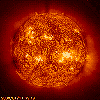| . |  |
. |
Greenbelt - February 1, 2000 - During the week of January 24th, while most of the Washington area was shut down for two days because of the snow storm, operations in the Terra Control Center continued. "It is fortunate that even this recent blizzard did not impede this Team," said Kevin Grady, Terra project manager at NASA's Goddard Space Flight Center, Greenbelt, Md. "The commitment of individuals on this Team remains phenomenal." Last week began with the MODIS instrument opening their space view door and configuring into science mode. Both of these activities were completed as planned. The first recorder dump of MODIS science data executed as planned and the data was routed to the DAAC and the MODIS Science Team for analysis. The nadir (Earth viewing) aperture door on MODIS is still closed, and it will remain in that state until the first engineering image is taken sometime in late February. In the middle of the snow storm, the ASTER instrument also took the opportunity to perform two pointing checks. Both of these movements were successful. The anomaly which has been given attention in recent weeks is the issue of the orbit ascent maneuvers. During the attempt of the first long ascent maneuver, Terra's flight computer detected a roll attitude anomaly, and properly aborted the maneuver approximately one minute into the burn. The data has now been analyzed and a strategy mapped-out for completing an ascent sequence. Three items have been identified as potential contributing factors to the anomalous behavior. Four firings will take place over the next week to prepare for the ascent sequence, and eliminate (or establish) anomalous thruster performance as one of the contributing factors. The first two firings are planned for this week. Controllers have a plan of performing a series of burns, which will place Terra in the operational orbit, in formation with Landsat 7. "It is a challenging plan, but safety is always first and foremost when the maneuvering of Terra is planned," Grady added. Just as the blizzard started last Tuesday morning, controllers were confronted with a data recorder anomaly on Terra. During a routine housekeeping recorder playback, the solid state recorder playback hung-up. This housekeeping playback operation followed a successful MODIS science playback and replay on the previous orbit. A number of diagnostics were run on the recorder in the hung state, and finally the recorder was reset to clear the anomaly. Housekeeping and science data recording and playback are now working nominally. Analysis and simulation are in process to determine the cause for this hang-up. High gain antenna radiation hits have been occurring periodically. Controllers are now seeing them on the descending passes through the South Atlantic Anomaly. The telemetry monitor continues to successfully restart the antenna after each of these events. Terra was launched from Vandenberg Air Force Base, Calif., on Dec. 18, 1999, at 1:57 p.m. EST, and is the "flagship" to the Earth Observing System series of satellites, part of a precedent setting program designed to provide daily information on the health of the Planet. The primary objective of the Terra Mission is to simultaneously will study clouds, water vapor, small particles in the atmosphere (called "aerosol" particles), trace gases, land surface and oceanic properties, as well as the interaction between them and their effect on the Earth's energy budget and climate.
 Pasadena - February 1, 2000 -
Pasadena - February 1, 2000 - Like the Earth, the Sun has a magnetic field whose north and south poles are tilted away from its rotation axis. The solar magnetic field reverses (the N pole becomes a S pole and vice versa) approximately every 11 years (the solar cycle). |
|
|
|
|
|
|
|
|
|
|
|
|
|
| The content herein, unless otherwise known to be public domain, are Copyright 1995-2006 - SpaceDaily.AFP and UPI Wire Stories are copyright Agence France-Presse and United Press International. ESA PortalReports are copyright European Space Agency. All NASA sourced material is public domain. Additionalcopyrights may apply in whole or part to other bona fide parties. Advertising does not imply endorsement,agreement or approval of any opinions, statements or information provided by SpaceDaily on any Web page published or hosted by SpaceDaily. Privacy Statement |